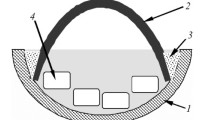Abstract
It is shown that the cylindrical iron and carbon–steel specimens of diameters 1.5 and 3 mm ignite in oxygen at the moment the oxide film loses its protective properties, supposedly, as a result of melting of its main component (FeO) at 1644 K. The ignition temperature does not depend on the oxygen pressure (in the range 0.2—20 MPa). The ignition is preceded by substantial (about 100 K) self–heating of a specimen owing to the heat released upon oxidation of the metal. A carbon–steel foil ignites in oxygen (0.14—0.6 MPa) according to the Semenov—Frank–Kamenetskii mechanism at an initial surface temperature not lower than 1233 K.
Similar content being viewed by others
REFERENCES
M. E. Derevyaga, L. N. Stesik, and É. A. Fedorin, “Ignition of titanium specimens in oxygen, ” Fiz. Goreniya Vzryva, 12, No. 4, 544-547 (1976).
Yu. A. Gal'chenko and Yu. M. Grigor'ev, “Ignition study of the kinetics of the interaction of tantalum with oxygen, ” Fiz. Goreniya Vzryva, 10, No. 2, 245-253 (1974).
M. E. Derevyaga, L. N. Stesik, and É. A. Fedorin, “Experimental study of the critical conditions for ignition of magnesium, ” Fiz. Goreniya Vzryva, 14, No. 6, 44-49 (1978).
Yu. M. Grigor'ev and A. A. Sarkisyan, “Kinetics and mechanism of the high-temperature interaction of niobium with oxygen, ” Fiz. Goreniya Vzryva, 14, No. 6, 82-88 (1978).
M. E. Derevyaga, L. N. Stesik, and É. A. Fedorin, “Ignition and combustion of refractory metals (tungsten, molybdenum, and boron), ” Fiz. Goreniya Vzryva, 15, No. 4, 17-29 (1979).
V. I. Bolobov and A. Yu. Berezin, “Conditions for ignition of copper and copper alloys in oxygen, ” Fiz. Goreniya Vzryva, 34, No. 2, 47-50 (1998).
V. I. Bolobov, A. Yu. Berezin, P. F. Drozhzhin, and A. S. Shteinberg, “Ignition of compact stainlesssteel specimens in high-pressure oxygen, ” Fiz. Goreniya Vzryva, 27, No. 3, 3-7 (1991).
V. I. Bolobov, “Effect of pressure on the ignition temperature of compact samples of nickel alloys in oxygen, ” Fiz. Goreniya Vzryva, 35, No. 2, 54-58 (1999).
A. L. Breiter, V. M. Mal'tsev, and E. I. Popov, “Ignition models of metals, ” Fiz. Goreniya Vzryva, 13, No. 4, 558-571 (1977).
M. Jacobson, A. R. Cooper, and J. Nagy, “Explosibility of metal powders, ” U.S. Bureau of Mines Report Investigation, No. 6516 (1964).
L. Ya. Nesgovorov, “Metallographic study of the combustion of iron in air ow, ” Izv. Akad. Nauk SSSR, Met., No. 1, 141-147 (1965).
L. E. Dean and W. R. Thompson, “Ignition characteristics of metals and alloys, ” J. Amer. Rocket Soc., 31, No. 7, 78-85 (1961).
A. V. Grosse and I. B. Convay, “Combustion of metals in oxygen, ” Indust. Eng. Chem., 50, No. 4, 663-666 (1958).
W. E. Croves, “Safe handling of large quantities of gaseous oxygen in steel pipelines, ” Iron Steel Eng., 42, No. 1, 88-95 (1965).
B. A. Ivanov and A. P. Nikonov, “Ignition and combustion of a compact metal in oxygen, ” in: Problems in Engineering Workplace Hygiene (collected papers) [in Russian], No. 63, Metallurgiya, Moscow (1970), pp. 55-63.
B. A. Ivanov, Safe Handling of Materials in Contact with Oxygen [in Russian], Khimiya, Moscow (1974).
A. T. Sosnovskii and N. I. Stolyarova, Temperature Measurement [in Russian], Izd. Standartov, Moscow (1970).
E. Fromm and E. G. Gebhart, Gases and Carbon in Metals [Russian translation], Metallurgiya, Moscow (1980).
O. Kubashewski and B. E. Hopkins, Oxidation of Metals and Alloys, Butterworths, London (1965).
J. B_enard (ed.), Oxydation des Metaux, Vol. 1, Gauthier-Villars, Paris (1962).
B. I. Khaikin, V. N. Bloshenko, and A. G. Merzhanov, “Ignition of metal particles, ” Fiz. Goreniya Vzryva, 5, No. 4, 474-488 (1970).
N. N. Semenov, “The theory of combustion, ” Zh. Ross. Fiz.-Khim. Obshch. Ser. Fiz., 60, 241 (1928).
D. A. Frank-Kamenetskii, Di_usion and Heat Transfer in Chemical Kinetics [in Russian], Nauka, Moscow (1987).
R. Friedman and A. Macek, “Ignition and combustion of aluminium particles in hot ambient gases, ” Combust. Flame, 6, 9 (1962).
Yu. V. Levinskii, Metal Gas Constitution Diagrams [in Russian], Metallurgiya, Moscow (1975).
V. I. Bolobov, P. F. Drozhzhin, and V. G. Nechaeva, “High-temperature oxidation and ignition of some metallic materials in uorine, ” Fiz. Goreniya Vzryva, 34, No. 4, 34-42 (1998).
Author information
Authors and Affiliations
Rights and permissions
About this article
Cite this article
Bolobov, V.I. Conditions for Ignition of Iron and Carbon Steel in Oxygen. Combustion, Explosion, and Shock Waves 37, 292–296 (2001). https://doi.org/10.1023/A:1017523922778
Issue Date:
DOI: https://doi.org/10.1023/A:1017523922778




